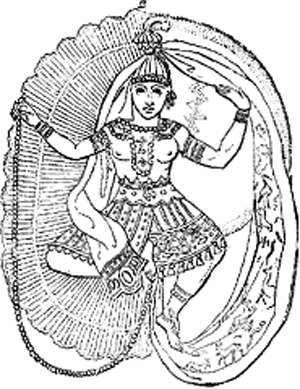

This figure represents Brahma-Maya or Mahat-Maya, Brahma Viraj, or the great Illusion.
The androgene or male-female, the Great Appearance, the first revelation of the Being or Brahman (neuter), under the form of the double-sexed first emanation. The neuter, became male and female, by separation into the male, positive, forming the spiritual — the entities or the noumena, and his sakti or female, the negative, or plastic, matter, the illusionary or phenomenal existence. The sakti, is his developing energy, force or potentiality. This symbol, the divine type of the first male and female, which can be compared with the terrestrial Adam before the final separation of Eve, is really in consonance with this Adam's perfect ideal, the Adam Kadmon or Heavenly Adam of the Kabbalah. The Brahma-half is on the right side, the good side, man's, the Maya-half is on the left, the evil side, the woman's. So according to the Hebrew sacred writings, through Eve the woman, evil was brought into the world. Compare with this the Greek myth of Pandora. Issuing from the linga-yoni is the pearl chain, or connected circle of the existences, looked upon as united atoms, and the symbol of all the existing. It is held up by the hand on the male side.
Brahman (neuter), appears here as manifested in the male in union with the female sakti, of the preformatory imagination, as the nine creative monarch and Pearl King, richly decorated with the circles of the soul-monads and atoms. On his head is the world egg cap. The veil of the existences, upon which are woven the ideas or models of the to-be-emanated existences, flows from the linga-yoni to the highest part of the head and thence down the right side. He as the male, has a tendency to twist himself upon himself and his face bears the stamp of deep meditation. The aureole of fire is on the male side and from it scintillate sparks upon the veil of Maya. On the Maya side, the attitude is that of joy or dancing; the hand raised as if in play, holds up the veil, bells are hanging on her robe and singularly the Egyptian hieroglyphic for the water of life is shown; while the bust is developed. Portrayed upon the veil are the prototypes of the creatures. Compare the symbolism of the girdle of Aphrodite and that of Venus.
As the double spouse of Brahman (neuter) considered apart and in opposition to It. The Brahma-Maya is the life in nature, of which, Brahman (neuter) is the soul. The Brahma-Maya is that blind energy and force, potential and powerful, and eternally fecund, which is incessantly producing under forms which are without cessation renewed; and which is adored in India to-day, as the Great Mother, the Universal Mother, in other words all nature deified. Maya is the mother of Love or Desire, the first principle or affinity of all affection, creation, matter. She is even matter itself, but the primitive subtile matter co-existing with God (Brahman, neuter) from all eternity, contained in It, and symbolized by the three colors, red, white, black; the three qualities or powers of creation, preservation and destruction, consequently the Trimurti, and also the three gunas (qualities), Truth, Action, and Indifference, of the Bhagavad Gita. (1) It is Maya, who through the attraction of her beauty, causes the Most High, from the bosom of Its ineffable profoundity, forgetting Itself, to unite Itself, in the intoxication of desire with that divine enchantress.
The mysterious veil, which she had woven with her hands, received entirely from both, and the thought of the Eternal Almighty became fecundated, and fell into Time. The innumerable forms of the creatures, represent the perfect ideals woven upon the magic tissue, the woven warp and woof of all existence, with which veil Maya (2) envelops her spouse and
causes the recurrence of the gift of life.
FOOTNOTES:
1. These three qualities are explained by Krishna in the Bhagavadgita, as Satwa good or inactive being purely spiritual; Rajas bad and active; and Tamas inactive or indifferent and bad. They exist in every human mind and are mingled in greater or less proportions at all times, according to the individual and also according to his varying circumstances. His teaching in regard to the Tamo guna is the same as that taught in the Christian Bible, for he says that for the indifferent man there is no salvation — he is as it were "ejected like a broken cloud;" and in I James v, 6, 7, the doubting man is declared incapable of obtaining anything, while in Rev. iii, 16, the Laodiceans are accused of being neither cold nor hot, that is of being indifferent, and they are condemned to be "spewed out of the mouth," which is the same as the fate described as awaiting those in whom indifference predominates, Krishna declaring that they become more and more deluded at each succeeding generation until at last they reach the lowest round of the ladder in the shape of primordial matter. The difference between the two schools is, that Krishna's allows the doctrines of Reincarnation and Karma, while the modern Christians, blind to their own Bible, reject these supremely important laws, or rather ignore them as yet. [Ed.] (return to text)
2. Maya is the Sanskrit for illusion. [Ed.] (return to text)